Applications of Blockchain Technology to Higher Education Arena: A Bibliometric Analysis
Abstract
:1. Introduction
2. Methodology
2.1. Data
2.2. Data Collect
2.3. Data Synthesis
2.4. Data Analysis
3. Results
3.1. Articles and Sources
- Cheng et al. [21] (53 Citations). In this study, named “Blockchain and smart contract for digital certificate”, the authors show the problem of certificate forgery by proposing a digital certificate system based on blockchain technology. This approach collaborates with Taiwan’s Ministry of Education, ensuring information security for students who receive degrees to enter the job market.
- Lizcano et al. [8] (38 Citations). In this study, named “Blockchain-based approach to create a model of trust in open and ubiquitous higher education”, the authors evaluate the benefits of blockchain technology and presents a model for transactions based on an academic cryptocurrency. They approach the blockchain to manage content, teaching and competency transactions, assessed by consensus by students, coaches and employers, to eliminate once and for all the “gap” between the academic world and the world of work.
- Ocheja et al. [22] (27 Citations). In this study, named “Managing lifelong learning records through blockchain,”, the authors presented the overview of the practical implementation of a new platform to track learning achievements, transcripts, and certificates. Discuss the resource requirements and compare the advantages against other similar tools.
- Swan [23] (26 Citations). In this study, named “Blockchain for Business: Next-Generation Enterprise Artificial Intelligence Systems” the author discusses the Blockchain approach in public and private contexts, considering enterprise deployments and next-generation artificial intelligence systems, notably deep learning blockchains. Other applications can be developed considering global automotive supply chains, healthcare, digital identity accreditation, higher education, and digital collections.
- Kamišalić et al. [24] (11 Citations). In this study, named “A Preliminary Review of Blockchain-Based Solutions in Higher Education”, the authors presented four types of blockchain initiatives through cases that address different aspects within the educational domain. They consider a preliminary review and analysis of the cases, showing that most follow a student-centered approach.
3.2. Authors and Countries
3.3. Analysis (Co-Citations Analysis, Co-Occurrence Analysis, and Keyword Cloud Analysis)
3.4. Blockchain Technology Applications in the Higher Education Arena
4. Discussion
Limitations of the Study and Future Line of Research
- (a)
- Investigate how students can have a secure shared data relationship with professors in real time.
- (b)
- A systematic literature review of blockchain enabled applications for scholars and software industries.
- (c)
- Determine the best data approach using blockchain.
- (d)
- Reduce the barrier in the higher education institutes to attract and retain students.
- (e)
- Application of blockchain technologies in the analysis of the digital maturity of health higher education institutions.
- (f)
- Understand the relationship between blockchain technology and digital learners.
- (g)
- Identify whether blockchain technology is at the heart of digital maturity models in the healthcare industry.
- (h)
- Develop a digital maturity model for health sector.
- (i)
- Measure the impact of blockchain technology in learning outcomes (competencies and skills).
5. Conclusions
Author Contributions
Funding
Institutional Review Board Statement
Informed Consent Statement
Data Availability Statement
Conflicts of Interest
Appendix A—List of Publications Review
References
- Alzahrani, B.; Bahaitham, H.; Andejany, M.; Elshennawy, A. How Ready Is Higher Education for Quality 4.0 Transformation According to the Lens Research Framework? Sustainability 2021, 13, 5169. [Google Scholar] [CrossRef]
- Zhang, C.; Wu, C.; Wang, X. Overview of Blockchain consensus mechanism. In Proceedings of the 2020 2nd International Conference on Big Data Engineering, Shanghai, China, 29–31 May 2020; pp. 7–12. [Google Scholar] [CrossRef]
- Awaji, B.; Solaiman, E.; Albshri, A. Blockchain-based applications in higher education: A systematic mapping study. In Proceedings of the 5th International Conference on Information and Education Innovations, London, UK, 26–28 July 2020; pp. 96–104. [Google Scholar]
- Huynh, T.T.; Tru Huynh, T.; Pham, D.K.; Khoa Ngo, A. Issuing and Verifying Digital Certificates with Blockchain. Int. Conf. Adv. Technol. Commun. 2018, 2018, 332–336. [Google Scholar]
- Castro, R.Q.; Au-Yong-Oliveira, M. Blockchain and higher education diplomas. Eur. J. Investig. Health Psychol. Educ. 2021, 11, 154–167. [Google Scholar] [CrossRef]
- Dharmalingam, R.; Ugail, H.; Shivasankarappa, A.N.; Dharmalingam, V. Framework for Digitally Managing Academic Records Using Blockchain Technology. In Mobile Computing and Sustainable Informatics; Springer: Singapore, 2022; pp. 633–645. [Google Scholar]
- Ronaghi, M.H. A blockchain maturity model in agricultural supply chain. Inf. Process. Agric. 2020, 8, 398–408. [Google Scholar] [CrossRef]
- Lizcano, D.; Lara, J.A.; White, B.; Aljawarneh, S. Blockchain-based approach to create a model of trust in open and ubiquitous higher education. J. Comput. High. Educ. 2020, 32, 109–134. [Google Scholar] [CrossRef]
- Panachev, A.; Shcherbitsky, V.; Medvedev, M.A. Application of blockchain technologies and game approach in the educational process of universities. AIP Conf. Proc. 2021, 2333, 100004. [Google Scholar]
- Devi, O.R. International Journal of Advanced Trends in Computer Science and Engineering. E3S Web Conf. 2015, 4, 15–21. Available online: http://www.warse.org/ijatcse/static/pdf/file/ijatcse02422015.pdf (accessed on 7 August 2021).
- Rahman, M.A.; Abuludin, M.S.; Yuan, L.X.; Islam, M.S.; Asyhari, A.T. EduChain: CIA-compliant block-chain for intelligent cyber defense of microservices in education industry 4.0. IEEE Trans. Ind. Inform. 2021. [Google Scholar] [CrossRef]
- Ali, M.A.; Bhaya, W.S. Higher Education’s Certificates Model based on Blockchain Technology. J. Phys. Conf. Ser. 2021, 1879, 022091. [Google Scholar] [CrossRef]
- Chang, I.F.; Chuang, Y.H.; Chen, T.L.; Yin, Y.P.; Liu, Y.N.; Chen, T.S. A Study on the Mechanism of Blockchain Cryptocurrency Implementation: Learning Coin of Campus. In Proceedings of the 2020 ACM International Conference on Intelligent Computing and its Emerging Applications, GangWon, Korea, 12–15 December 2020; pp. 1–2. [Google Scholar] [CrossRef]
- Sowmiya, B.; Poovammal, E. A Heuristic K-Anonymity Based Privacy Preserving for Student Management Hyperledger Fabric blockchain. Wirel. Pers. Commun. 2021. [Google Scholar] [CrossRef]
- Figueiredo, R.; Ferreira, J.J.M. Spinner Model: Prediction of Propensity to Innovate Based on Knowledge-Intensive Business Services. J. Knowl. Econ. 2020, 11, 1316–1335. [Google Scholar] [CrossRef]
- Figueiredo, R.; Ferreira, J.J.M.; Silveira, R.G.; Villarinho, A.T. Innovation and co-creation in knowledge intensive business services: The Spinner model. Bus. Process Manag. J. 2019, 26, 909–923. [Google Scholar] [CrossRef]
- Soliman, M.; Di Virgilio, F.; Figueiredo, R.; Sousa, M.J. The impact of workplace spirituality on lecturers’ attitudes in tourism and hospitality higher education institutions. Tour. Manag. Perspect. 2021, 38, 100826. [Google Scholar] [CrossRef]
- Aria, M.; Cuccurullo, C. Bibliometrix: An R-tool for comprehensive science mapping analysis. J. Informetr. 2017, 11, 959–975. [Google Scholar] [CrossRef]
- Rashid, S.; Khattak, A.; Ashiq, M.; Rehman, S.U.; Rasool, M.R. Educational landscape of virtual reality in higher education: Bibliometric evidences of publishing patterns and emerging trends. Publications 2021, 9, 17. [Google Scholar] [CrossRef]
- Bettencourt, S.; Costa, S.; Caeiro, S. Marine litter: A review of educative interventions. Mar. Pollut. Bull. 2021, 168, 112446. [Google Scholar] [CrossRef]
- Cheng, J.-C.; Lee, N.-Y.; Chi, C.; Chen, Y.-H. Blockchain and smart contract for digital certificate. In Proceedings of the 4th IEEE International Conference on Applied System Innovation 2018 (ICASI), Chiba, Japan, 13–17 April 2018; pp. 1046–1051. [Google Scholar]
- Ocheja, P.; Flanagan, B.; Ueda, H.; Ogata, H. Managing lifelong learning records through blockchain. Res. Pract. Technol. Enhanc. Learn. 2019, 14, 4. [Google Scholar] [CrossRef] [Green Version]
- Swan, M. Blockchain for Business: Next-Generation Enterprise Artificial Intelligence Systems. In Blockchain Technology: Platforms, Tools and Use Cases; Purdue University: West Lafayette, IN, USA, 2018. [Google Scholar] [CrossRef]
- Kamišalić, A.; Turkanović, M.; Mrdović, S.; Heričko, M. A Preliminary Review of Blockchain-Based Solutions in Higher Education. Commun. Comput. Inf. Sci. 2019, 1011, 114–124. [Google Scholar]
- Agbo, F.J.; Oyelere, S.S.; Suhonen, J.; Tukiainen, M. Scientific production and thematic breakthroughs in smart learning environments: A bibliometric analysis. Smart Learn. Environ. 2021, 8, 1. [Google Scholar] [CrossRef]
- Ali, M.A.; Bhaya, W.S. Higher Education’s Certificates Model based on Blockchain Technology. In Proceedings of the Ibn Al-Haitham International Conference for Pure and Applied Sciences (IHICPS), Baghdad, Iraq, 9–10 December 2020. [Google Scholar]
- Walcott-Bryant, A.; Ogallo, W.; Remy, S.L.; Tryon, K.; Shena, W.; Bosker-Kibacha, M. Addressing Care Continuity and Quality Challenges in the Management of Hypertension: Case Study of the Private Health Care Sector in Kenya. J. Med. Internet Res. 2021, 23, e18899. [Google Scholar] [CrossRef]
- Liang, X.; Zhao, Q.; Zhang, Y.; Liu, H.; Zhang, Q. EduChain: A highly available education consortium blockchain platform based on Hyperledger Fabric. Concurr. Comput. 2021, 1–17. [Google Scholar] [CrossRef]
- Kapliienko, O.; Tabunshchyk, G.; Kapliienko, T.; Wolff, C. Intellectual Property Assurance Method for Digital University Ecosystem based on Blockchain Technology. CMIS 2021, 1879, 312–323. [Google Scholar]
- Woods, R.; Doherty, O.; Stephens, S. Technology driven change in the retail sector: Implications for higher education. Ind. High. Educ. 2021. [Google Scholar] [CrossRef]
- Ist, A.; Sanit, S. COVID-19 and digital competencies among young physicians: Are we (really) ready for the new era? A national survey of the Italian Young Medical Doctors Association. Ann. Dell’istituto Super. Sanità 2021, 57, 1–6. [Google Scholar]
- Jordaan, D.B. LinkLearn: Blockchain Technology as a Learning Tool. Advances in Intelligent Systems and Computing. In Proceedings of the 13th IMCL Conference, Thessaloniki, Greece, 31 October–1 November 2019. [Google Scholar] [CrossRef]
- Kumaresh, S. Academic Blockchain: An Application of Blockchain Technology in Education System. In Advances in Intelligent Systems and Computing; ICDMAI 2020; Springer: Singapore, 2021. [Google Scholar] [CrossRef]
- Tyagi, D.; Ghosh, S.; Rana, A.; Kansal, V. A comparative analysis of potential factors and impacts that affect blockchain technology in software: Based applications. In Proceedings of the 2020 9th International Conference on System Modeling and Advancement in Research Trends (SMART), Moradabad, India, 4–5 December 2020; pp. 127–136. [Google Scholar]
- Hidrogo, I.; Zambrano, D.; Hernandez-de-Menendez, M.; Morales-Menendez, R. Mostla for engineering education: Part 1 initial results. Int. J. Interact. Des. Manuf. 2020, 14, 1429–1441. [Google Scholar] [CrossRef]
- El-Dorry, A.; Reda, M.; El Khalek, S.A.; El-Din Mohamed, S.; Mohamed, R.; Nabil, A. Egyptian Universities Digital Certificate Verification Model Using Blockchain. In Proceedings of the ACM International Conference Proceeding Series, Cairo, Egypt, 11–13 November 2020; pp. 79–83. [Google Scholar] [CrossRef]
- Yue, P.; Xiaofeng, Y.; Huagang, Z. Blockchain Technology and Higher Education: Characteristics, Dilemma and Development Path. In Proceedings of the ACM International Conference Proceeding Series, Yamanashi, Japan, 6–8 November 2020; pp. 173–176. [Google Scholar] [CrossRef]
- Zhang, L.; Ma, Z.; Ji, X.; Wang, C. Blockchain: Application in the System of Teaching Informatization Management of Higher Education. In Proceedings of the 2020 3rd International Conference on Smart BlockChain (SmartBlock), Zhengzhou, China, 23–25 October 2020; pp. 185–190. [Google Scholar]
- Chehade, M.J.; Yadav, L.; Kopansky-Giles, D.; Merolli, M.; Palmer, E.; Jayatilak, A.; Salter, H. Innovations to improve access to musculoskeletal care. Best Pract. Res. Clin. Rheumatol. 2020, 34, 101559. [Google Scholar] [CrossRef]
- Ceke, D.; Kunosic, S. Smart contracts as a diploma anti-forgery system in higher education—A pilot project. In Proceedings of the 2020 43rd International Convention on Information, Communication and Electronic Technology (MIPRO), Opatija, Croatia, 28 September–2 October 2020; pp. 1662–1667. [Google Scholar]
- Bolsens, I. Scalable system and silicon architectures to Handle the workloads of the Post-Moore era. In Proceedings of the International Symposium on Physical Design, Taipei, Taiwan, 20–23 September 2020; pp. 1–2. [Google Scholar] [CrossRef]
- Priya, N.; Ponnavaikko, M.; Aantonny, R. Anomaly detection in document verification system using deeplearning in hyperledger. Int. J. Adv. Trends Comput. Sci. Eng. 2020, 9, 8632–8636. [Google Scholar]
- Abougalala, R.A.; Amasha, M.A.; Areed, M.F.; Alkhalaf, S.; Khairy, D. Blockchain-enabled smart University: A framework. J. Theor. Appl. Inf. Technol. 2020, 98, 3531–3543. [Google Scholar]
- Sharma, S.; Batth, R.S. Blockchain Technology for Higher Education Sytem: A Mirror Review. In Proceedings of the International Conference on Intelligent Engineering and Management (ICIEM), London, UK, 17–19 June 2020; pp. 348–353. [Google Scholar]
- Vidal, F.; Gouveia, F.; Soares, C. Analysis of blockchain technology for higher education. In Proceedings of the 2019 International Conference on Cyber-Enabled Distributed Computing and Knowledge Discovery (CyberC), Guilin, China, 17–19 October 2019; pp. 28–33. [Google Scholar]
- Shukla, A.; Indra, S.; Trivedi, T.J.; Ujjwala, S.; Monica, C. Academic credential verification technique using blockchain. Int. J. Adv. Sci. Technol. 2020, 29, 4244–4254. [Google Scholar]
- Zhao, G.; Di, B.; He, H. Design and Implementation of the Digital Education Transaction Subject Two-factor Identity Authentication System Based on Blockchain. In Proceedings of the International Conference on Advanced Communication Technology (ICACT), Phoenix Park, Korea, 16–19 February 2020; pp. 176–180. [Google Scholar]
- Vidal, F.R.; Gouveia, F.; Soares, C. Blockchain application in higher education diploma management and results analysis. Adv. Sci. Technol. Eng. Syst. 2020, 5, 871–882. [Google Scholar] [CrossRef]
- Pfeiffer, A.; Bezzina, S.; Wernbacher, T.; Kriglstein, S. Blockchain technologies for the validation, verification, authentication and storing of students’ data. In Proceedings of the European Conference on e-Learning, ECEL, Berlin, Germany, 18–30 October 2020; Volume 2020, pp. 421–427. [Google Scholar] [CrossRef]
- Paraschiveanu, V.; Richardson, G.; Voicu-Dorobanțu, R. Education 3.0: Blockchain-backed moocs. Elearning Softw. Educ. Conf. 2020, 3, 82–90. [Google Scholar] [CrossRef]
- Wishnow, D.; Azar, H.R.; Rad, M.P. A Deep Dive into Disruptive Technologies in the Oil and Gas Industry. In Proceedings of the Offshore Technology Conference Brasil, Rio de Janeiro, Brazil, 29–31 October 2019. [Google Scholar] [CrossRef]
- Mori, K.; Miwa, H. Digital University Admission Application System with Study Documents Using Smart Contracts on Blockchain. In Proceedings of the INCoS 2019: Advances in Intelligent Systems and Computing, Oita, Japan, 5–7 September 2019. [Google Scholar] [CrossRef]
- Liu, Q.; Zou, X. Research on trust mechanism of cooperation innovation with big data processing based on blockchain. EURASIP J. Wirel. Commun. Netw. 2019, 2019, 26. [Google Scholar] [CrossRef]
- Hou, Y.; Wang, N.; Mei, G.; Xu, W.; Shao, W.; Liu, Y. Educational Resource Sharing Platform Based on Blockchain Network. In Proceedings of the 2019 Chinese Automation Congress (CAC), Hangzhou, China, 22–24 November 2019; pp. 5491–5494. [Google Scholar]
- Smirnov, V.V.; Zakharova, A.N.; Semenov, V.L.; Mulendeeva, A.V.; Suchkova, A.G. Analysis of the Russian digital economy profile. In Proceedings of the ACM International Conference Proceeding Series, Saint Petersburg, Russia, 24–25 October 2019. [Google Scholar] [CrossRef]
- Ricci, P.; Mammanco, V. RemBit: A blockchain based solution for remittances to Ethiopia. In Proceedings of the 2019 IEEE Symposium on Computers and Communications (ISCC), Barcelona, Spain, 29 June–3 July 2019; Volume 2019. [Google Scholar]
- Seneviratne, M.; Peiris, D. Digital Health in Low and Middle Income Countries. Revolut. Trop. Med. 2019, 566–583. [Google Scholar] [CrossRef]
- Narman, H.S.; Uulu, A.D.; Liu, J. Profile Analysis for Cryptocurrency in Social Media. In Proceedings of the 2018 IEEE International Symposium on Signal Processing and Information Technology (ISSPIT), Louisville, KY, USA, 6–8 December 2018; pp. 229–234. [Google Scholar]
- Turlacu, L.-M.; Orzan, G.; Chivu, R.-G. Strategic Technologies: Innovation in Higher Education in Romania. In Proceedings of the the 15th International Scientific Conference eLearning and Software for Education, Bucharest, Romania, 11–12 April 2019; p. 12753. [Google Scholar]
- Oliveira, T.; Thomas, M.; Espadanal, M. Assessing the determinants of cloud computing adoption: An analysis of the manufacturing and services sectors. Inf. Manag. 2014, 51, 497–510. [Google Scholar] [CrossRef]
- Ma, X.; Xu, L.; Xu, L. Blockchain Retrieval Model Based on Elastic Bloom Filter. In Proceedings of the WISA 2019: Web Information Systems and Applications, Qingdao, China, 20–22 September 2019. [Google Scholar]
- Fernández-Torres, Y.; Gutiérrez-Fernández, M.; Palomo-Zurdo, R. How do co-operative banks perceive the impact of digital transformation? [¿Cómo percibe la banca cooperativa el impacto de la transformación digital?]. CIRIEC-Espana Rev. Econ. Publica Soc. Coop. 2019, 11–38. [Google Scholar] [CrossRef]
- Ritzer, G.; Jandrić, P.; Hayes, S. The velvet cage of educational con(pro)sumption. Open Rev. Educ. Res. 2018, 5, 113–129. [Google Scholar] [CrossRef]
- Neilson, D.; Hara, S.; Mitchell, I. Bitcoin forensics: A tutorial. In Proceedings of the Global Security, Safety and Sustainability—The Security Challenges of the Connected World, London, UK, 18–20 January 2017. [Google Scholar] [CrossRef]
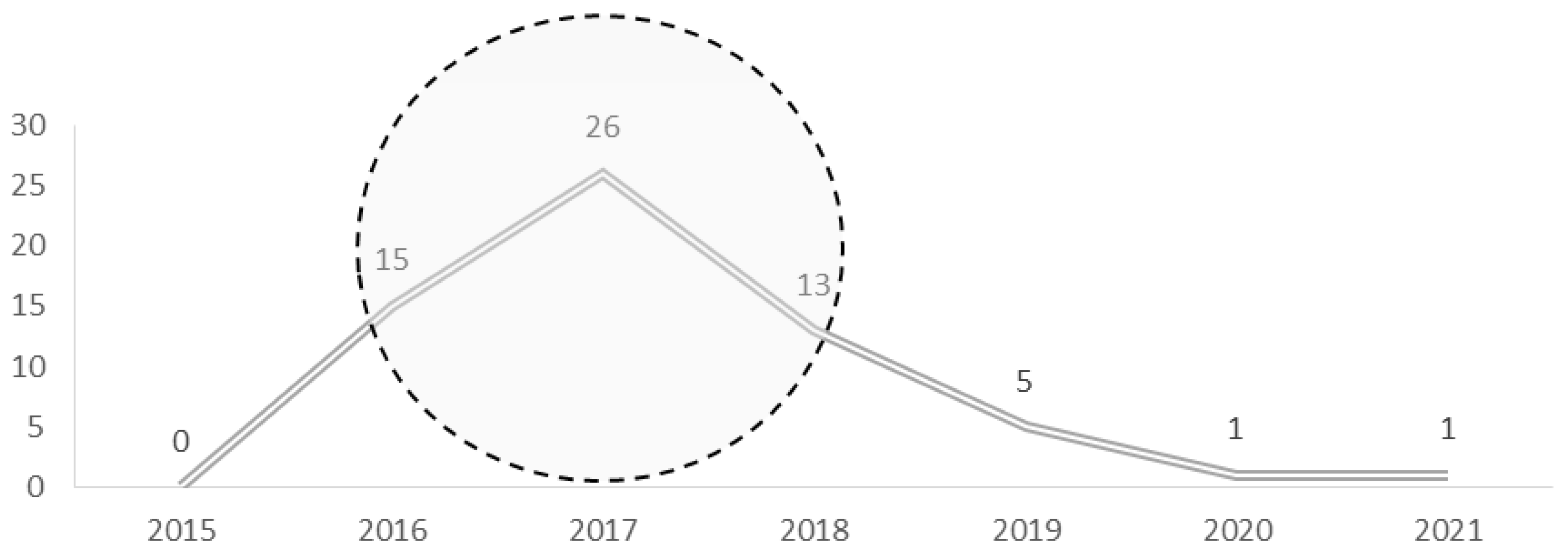
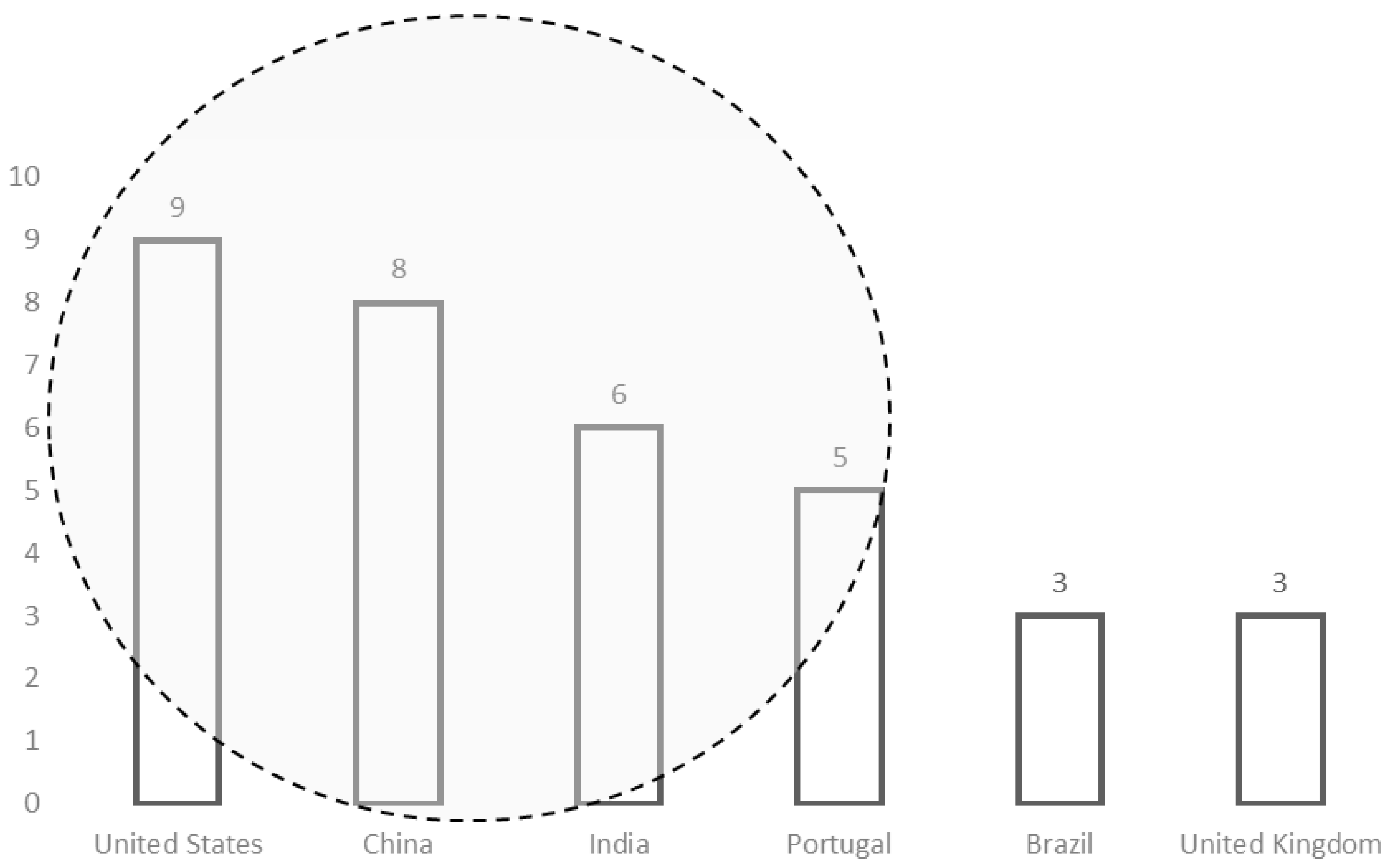
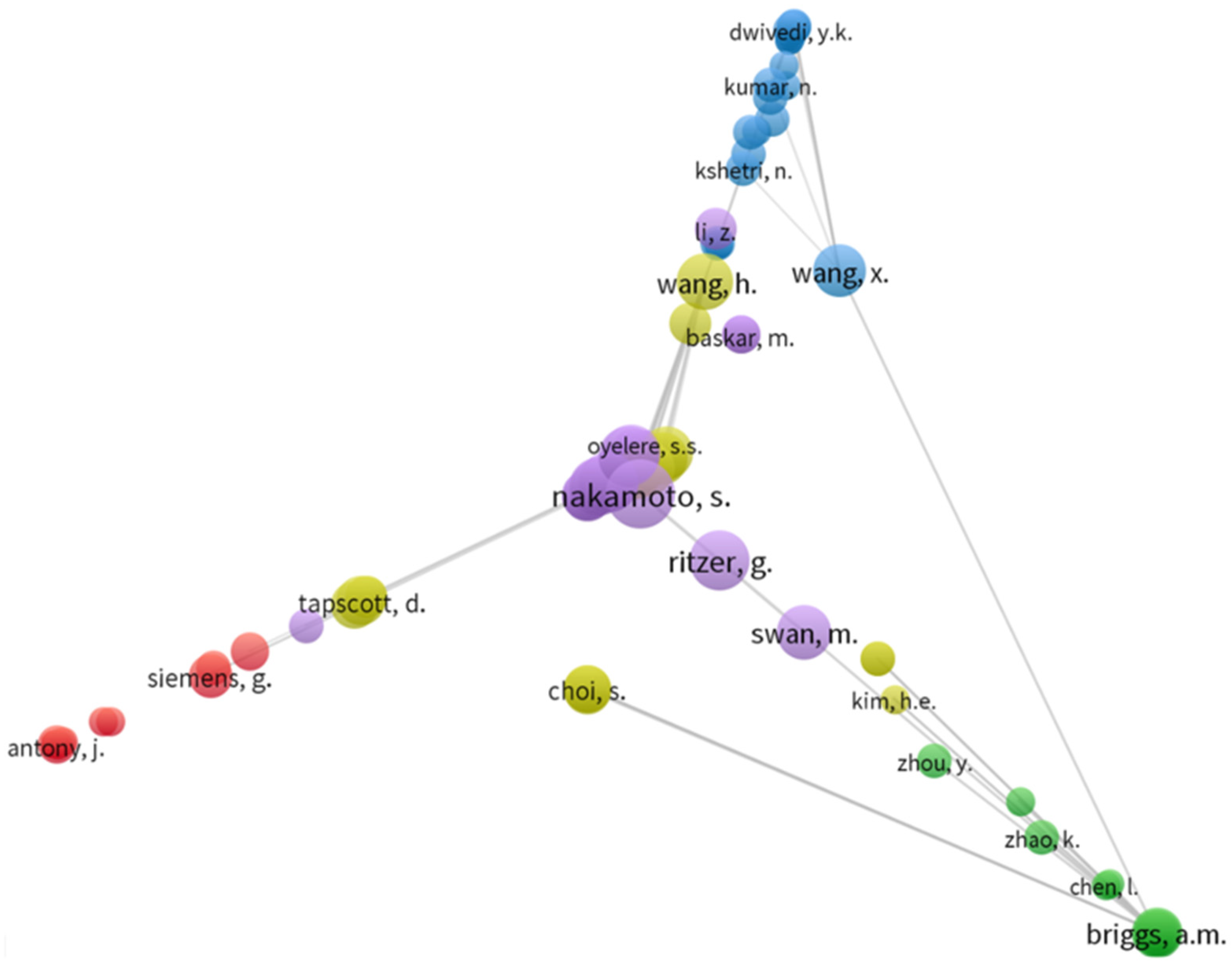
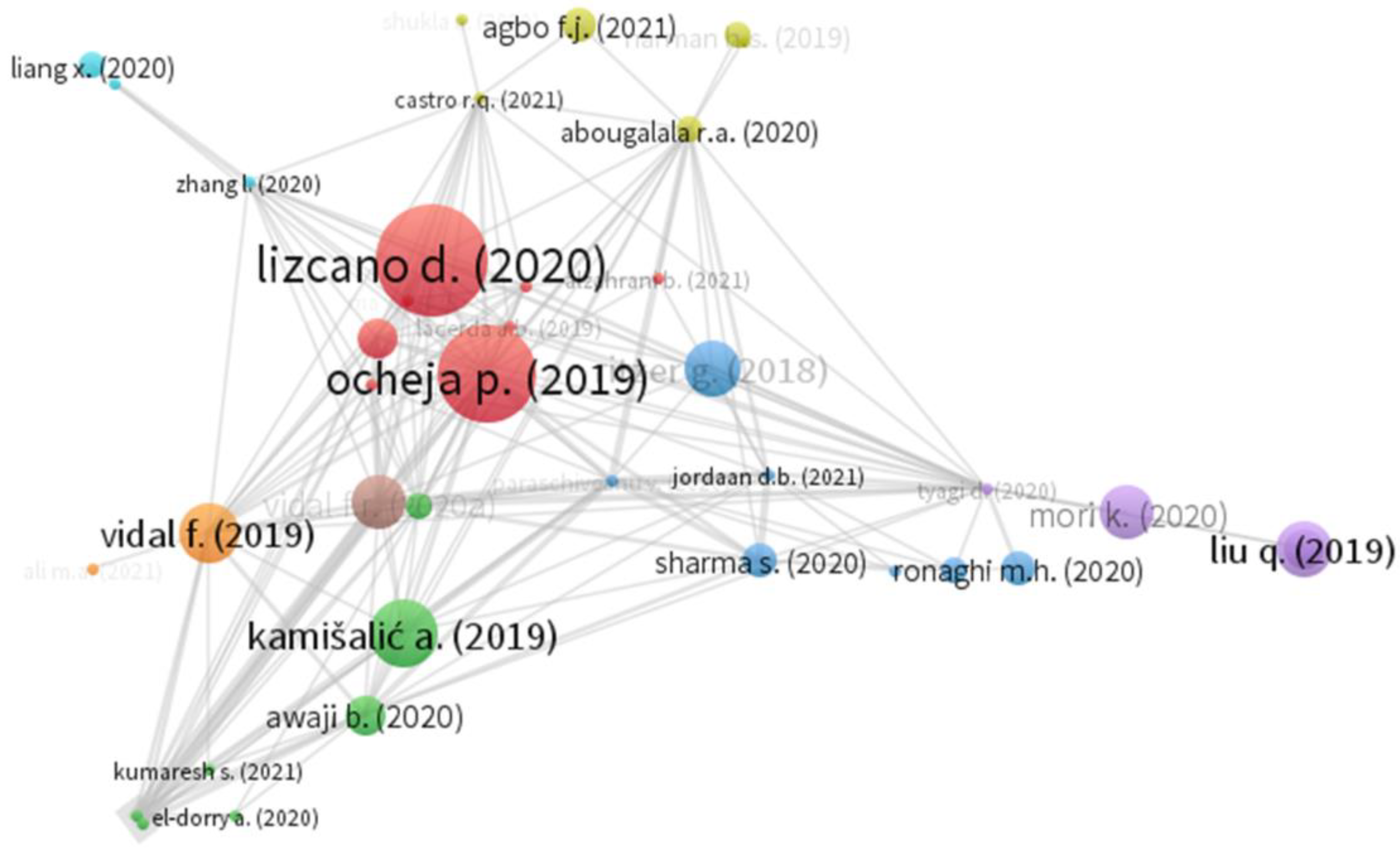
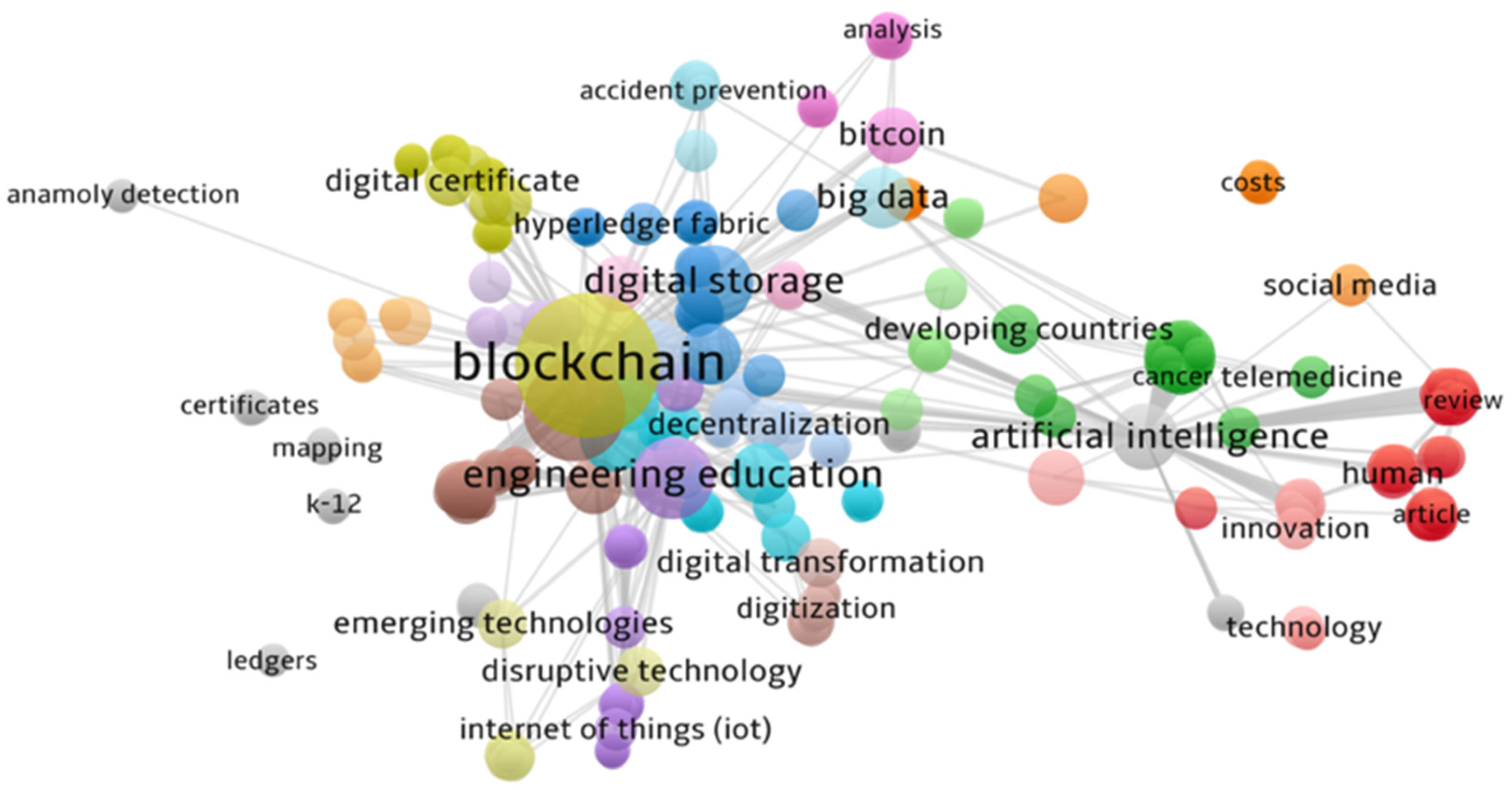

| Description | Results |
|---|---|
| Documents | 61 |
| Articles | 14 |
| Book Chapters | 2 |
| Conference Papers | 32 |
| Conference Reviews | 9 |
| Reviews | 4 |
| Sources | 2 |
| Keywords Plus | 305 |
| Author’s Keywords | 178 |
| Period | 2016–2021 |
| Average citations per documents | 4.23 |
| Principal Authors | 42 |
| Documents per Author | 1.5 |
| Subject Areas | 14 |
| Affiliation | 106 |
| Funding Sponsor | 18 |
| Article | # of Citations | |
|---|---|---|
| 1 | Cheng et al. [21] | 53 |
| 2 | Lizcano et al. [8] | 38 |
| 3 | Ocheja et al. [22] | 27 |
| 4 | Swan [23] | 26 |
| 5 | Kamišalić et al. [24] | 11 |
| Source | # Articles | # Citescore | # SJR | # SNIP |
|---|---|---|---|---|
| Advances in Intelligent Systems and Computing | 5 | 0.9 | 0.184 | 0.428 |
| ACM International Conference Proceeding Series | 4 | 1.2 | 0.182 | 0.296 |
| Communications in Computer and Information Science | 4 | 0.8 | 0.16 | 0.32 |
| Ceur Workshop Proceedings | 2 | 0.8 | 0.177 | 0.345 |
| Advances in Science Technology and Engineering Systems | 2 | 0.6 | 0.139 | 0.456 |
| Authors | Articles |
|---|---|
| Gouveia, F. | 4 |
| Soares, C. | 4 |
| Vidal, F.R. | 3 |
| Liang, X. | 2 |
| Zhao, Q. | 2 |
| Institute | No. of Articles |
|---|---|
| Universidade Fernando Pessoa | 4 |
| SRM Institute of Science and Technology | 2 |
| University of Central Florida | 2 |
| Bucharest University of Economic Studies | 2 |
| Number | Authors | Publication Year | Blockchain Technology Applications |
|---|---|---|---|
| 1 | (Agbo, Oyelere, Suhonen, and Tukiainen) | 2021 | Smart learning environments |
| 2 | (M A Ali and Bhaya) | 2021 | Blockchain model |
| 3 | (B Alzahrani, Bahaitham, Andejany, and Elshennawy) | 2021 | Quality 4.0 transformation process |
| 4 | (A Panachev, Shcherbitsky, and Medvedev) | 2021 | Educational software products elaboration. |
| 5 | (Walcott-Bryant et al.) | 2021 | Digital platform |
| 6 | (Liang, Zhao, Zhang, Liu, and Zhang) | 2021 | Education consortium blockchain platform |
| 7 | (Kapliienko, Tabunshchyk, Kapliienko, and Wolff) | 2021 | University digital ecosystem |
| 8 | (Sowmiya and Poovammal) | 2021 | Privacy system manager |
| 9 | (R Q Castro and Au-Yong-oliveira) | 2021 | Diploma certification. |
| 10 | (Woods, Doherty, and Stephens) | 2021 | Upskill development |
| 11 | (Casà et al.) | 2021 | Pre- and post-graduation training in digital |
| 12 | [No author name available]/proceedings | 2021 | - |
| 13 | [No author name available]/proceedings | 2021 | - |
| 14 | (Jordaan) | 2021 | Learning tool |
| 15 | (Kumaresh) | 2021 | Academic blockchain (transparent and secured system for sharing academic records and student’s achievements) |
| 16 | (Tyagi, Ghosh, Rana, and Kansal) | 2020 | Blockchain applications across multiple domains (social medias, education, crypto-currency, information technology and data management) |
| 17 | (Hidrogo, Zambrano, Hernandez-de-Menendez, and Morales-Menendez) | 2020 | Virtual reality zones, collaborative virtual reality, I 360° courses, blockchain for digital credentials, and digital tutors. |
| 18 | (El-Dorry et al.) | 2020 | Document certification |
| 19 | (Peng, Yang, and Zhou) | 2020 | Education system |
| 20 | (Zhang, Ma, Ji, and Wang) | 2020 | Teaching informatization management |
| 21 | (Chehade et al.) | 2020 | Empowerment |
| 22 | Ceke, D., Kunosic, S. (Ceke and Kunosic) | 2020 | Diplomas in education |
| 23 | (Bolsens) | 2020 | - |
| 24 | (Priya, Ponnavaikko, and Aantonny) | 2020 | Verification of certificates |
| 25 | (Abougalala, Amasha, Areed, Alkhalaf, and Khairy) | 2020 | Smart university |
| 26 | (B Awaji, Solaiman, and Albshri) | 2020 | Learning processes (certificate/degree verification, student assessments and exams, credit transfer, data management and admissions) |
| 27 | (Sharma and Batth) | 2020 | Educational bodies model |
| 28 | (Vidal, Gouveia, and Soares) | 2020 | Digital diplomas |
| 29 | (Liang et al.) | 2020 | Microservices architecture (innovation) |
| 30 | (Shukla, Indra, Trivedi, Ujjwala, and Monica) | 2020 | Digital certificates |
| 31 | (D Lizcano, Lara, White, and Aljawarneh) | 2020 | Model for training institution to adapt teaching. |
| 32 | (Zhao, Di, and He) | 2020 | Digital identify |
| 33 | (Vidal, Gouveia, and Soares) | 2020a | Verifying and sharing certificates. |
| 34 | (Pfeiffer, Bezzina, Wernbacher, and Kriglstein) | 2020 | - |
| 35 | (M H Ronaghi) | 2020 | Maturity of blockchain technology |
| 36 | (Paraschiveanu, Richardson, and Voicu-Dorobanțu) | 2020 | Legally binding smart-contracts; streamline the credentials’ processes and viability and legitimacy of education protection. |
| 37 | [No author name available] proceedings | 2020 | Digital transformation; digital infrastructure; digital ecosystem; digital collaboration; digital competences; blockchain accounting and blockchain adoption. |
| 38 | [No author name available] proceedings | 2020 | Artificial intelligence |
| 39 | (Wishnow, Azar, and Rad) | 2020 | Digital Twin 2.0 |
| 40 | [No author name available] Proceedings | 2020 | Blockchain data; smart contracts; learning conceptual modeling and class and object diagrams. |
| 41 | (Mori and Miwa) | 2020 | Falsification of information |
| 42 | (Ocheja, Flanagan, Ueda, and Ogata) | 2020 | Blockchain of learning logs (BOLL) platform |
| 43 | (Liu and Zou) | 2019 | Cooperation innovation of industry, universities, and research institutes. |
| 44 | (Hou et al.) | 2019 | Educational resource sharing |
| 45 | (Smirnov, Zakharova, Semenov, Mulendeeva, and Suchkova) | 2019 | Digital economy profile |
| 46 | (F. Vidal, Gouveia, and Soares) | 2019 | Academic diplomas |
| 47 | (Ricci and Mammanco) | 2019 | Innovative blockchain based system for safety |
| 48 | (Seneviratne and Peiris) | 2019 | Digital health tools, molile. |
| 49 | (Narman, Uulu, and Liu) | 2019 | Cryptocurrency draws |
| 50 | (Turlacu, Orzan, Chivu, and Herrezeel) | 2019 | Customer experience |
| 51 | (Ma, Xu, and Xu) | 2019 | Authenticity of data/smart contracts |
| 52 | (Fernández-Torres, Gutiérrez-Fernández, and Palomo-Zurdo) | 2019 | Digital education process |
| 53 | [No author name available] Proceedings | 2019 | Digital Devices |
| 54 | [No author name available] Proceedings | 2019 | Digital innovations |
| 55 | (T T Huynh, Tru Huynh, Pham, and Khoa Ngo) | 2018 | Education managers |
| 56 | (Cheng, Lee, Chi, and Chen) | 2018 | Smart contract for digital certificate |
| 57 | (Ritzer et al.) | 2018 | Digital transformation |
| 58 | [No author name available] proceedings | 2018 | ERP education; track digital assets of value and digital entrepreneurship. |
| 59 | (Swan) | 2018 | Digital collectibles (cryptokitties); artificial intelligence systems and deep learning algorithms. |
| 60 | [No author name available] proceedings | 2018 | Education services; digital tools and platforms for training programme; digital services and digital transformation. |
| 61 | (Neilson, Hara, and Mitchell) | 2018 | Digital cryptocurrency Bitcoin |
Publisher’s Note: MDPI stays neutral with regard to jurisdictional claims in published maps and institutional affiliations. |
© 2021 by the authors. Licensee MDPI, Basel, Switzerland. This article is an open access article distributed under the terms and conditions of the Creative Commons Attribution (CC BY) license (https://creativecommons.org/licenses/by/4.0/).
Share and Cite
Reis-Marques, C.; Figueiredo, R.; de Castro Neto, M. Applications of Blockchain Technology to Higher Education Arena: A Bibliometric Analysis. Eur. J. Investig. Health Psychol. Educ. 2021, 11, 1406-1421. https://doi.org/10.3390/ejihpe11040101
Reis-Marques C, Figueiredo R, de Castro Neto M. Applications of Blockchain Technology to Higher Education Arena: A Bibliometric Analysis. European Journal of Investigation in Health, Psychology and Education. 2021; 11(4):1406-1421. https://doi.org/10.3390/ejihpe11040101
Chicago/Turabian StyleReis-Marques, Carlos, Ronnie Figueiredo, and Miguel de Castro Neto. 2021. "Applications of Blockchain Technology to Higher Education Arena: A Bibliometric Analysis" European Journal of Investigation in Health, Psychology and Education 11, no. 4: 1406-1421. https://doi.org/10.3390/ejihpe11040101
APA StyleReis-Marques, C., Figueiredo, R., & de Castro Neto, M. (2021). Applications of Blockchain Technology to Higher Education Arena: A Bibliometric Analysis. European Journal of Investigation in Health, Psychology and Education, 11(4), 1406-1421. https://doi.org/10.3390/ejihpe11040101







